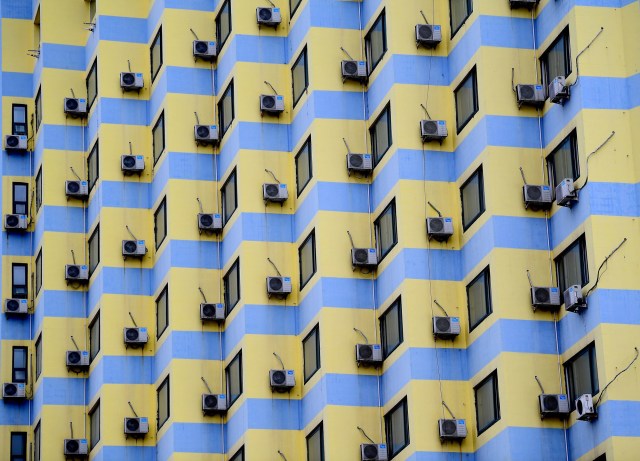Air conditioning units in Shenyang, Liaoning Province of China. Credit: VCG

I can’t stand this time of year – the sweaty, red-faced, over-heated horror of it all.
No, I don’t mean the weather, but the incessant arguments about the rights and wrongs of air conditioning.
It all kicked-off again on Twitter after Taylor Lorenz, a staff writer at The Atlantic, let off some steam:
“Air-conditioning is unhealthy, bad, miserable, and sexist. I can’t explain how many times I’ve gotten sick over the summer b/c of overzealous AC in offices. #BanAC”
The blow-back was fierce. A number of men pointed out that while female workers can don more layers if they’re feeling cold in the office, restrictive dress codes leave male workers sweltering in their suits and ties. That’s true in some workplaces, but perhaps those affected should man-up and tell their bosses where they can stick their antiquated rules.
Then again, it isn’t just men getting hot under the collar. A number of women also replied to Lorenz, insisting that they too were OK with AC. Some of them came from America’s Sunbelt states where ‘central air’ is an essential; others said they worked in stifling environments like warehouses and would kill for some chill; and then there were people of both sexes with heat-sensitive medical conditions.
Of course, all of this is rather anecdotal. Is there any hard evidence that air conditioning is sexist? A balanced piece in the New York Times by Penelope Green examines the issue:
“There is an oft-cited study published in Nature.com that notes how building temperatures, once set to the comfort preferences of 1960s-era men in suits, disregard the ‘thermal comfort’ of female staffers.”
This would fit with the long established practice of designating the adult male as the ‘standard human’ – and designing the modern world accordingly. Invisible Women by Caroline Criado Perez has chapter and verse this phenomenon, but how relevant is it to air conditioning in the 21st century?
If I understand Green correctly, the reality is that thermostat settings have not been frozen in time:
“Building temperatures are largely controlled by building managers, to industry standards that aim for the thermal comfort of 80 percent of a building’s occupants — which means, of course, that 20 percent will be uncomfortable, if not miserable.
“Those standards are updated regularly by the American Society of Heating, Refrigerating and Air Conditioning Engineers, which suggests that building temperatures range from 67 to 82 degrees Fahrenheit and be set according to an enormously complicated calculus.”
Research appears to suggest that there is no great battle of the sexes on this issue:
“It turns out gender is less a predictor of thermal comfort than other factors, like age, activity level or, tellingly, the relative wealth of the society surveyed, according to studies conducted by researchers at the Center for the Built Environment at the University of California, Berkeley.”
In any case, many modern workplaces – especially those divided into smaller units – have controls that can be adjusted room-by-room by whoever’s working there. This allows small groups of people, who’ll have to live with the consequences, to reach common sense compromises. I’m glad to say that’s how it is at UnHerd HQ, where tempers remain cool throughout the summer.
I suspect that conflict is most likely to arise in buildings where temperatures are set remotely (possibly by a facilities management company) and imposed without variation across a large area. As in so many other contexts, this is a great way of making really stupid decisions.
But if setting the temperature for one building is a fraught exercise, imagine the same challenge on a planetary scale.
Air con is supremely symbolic of the dilemmas presented by climate change. As a rapidly growing source of energy demand, it is both a contributor to, and made necessary by, rising temperatures. But it is about to acquire added symbolism.
Until now, action against global warming has been all about reducing greenhouse gas emissions – an unintended side-effect of various economic activities. However, even under the most optimistic decarbonisation scenarios, there will be significant additional warming over the decades ahead and thus an increasing pressure to actively cool the planet by means of geoengineering.
This, as I’ve written previously, is the riskiest of propositions, only worth contemplating as a last resort. And yet, some of the possible methods are surprisingly affordable – as in not requiring a multinational, multi-trillion dollar effort. In theory, a big company or a billionaire could bankroll enough geoengineering to have an appreciable influence on the global climate. So could all but the smallest and/or poorest of the world’s sovereign states – any of which could choose to take matters into their own hands if the conventional fight against climate change falters.
Of course, rather like the warring factions in an open plan office, a global temperature drop that suits some players (e.g. the too hot countries) won’t suit others (e.g. the too cold ones).
It’s one thing to stop heating up the Earth accidentally, quite another to deliberately cool it down. If we’re foolish enough to build a thermostat for the entire planet, expect a world-wide fight for the controls.










Join the discussion
Join like minded readers that support our journalism by becoming a paid subscriber
To join the discussion in the comments, become a paid subscriber.
Join like minded readers that support our journalism, read unlimited articles and enjoy other subscriber-only benefits.
Subscribe